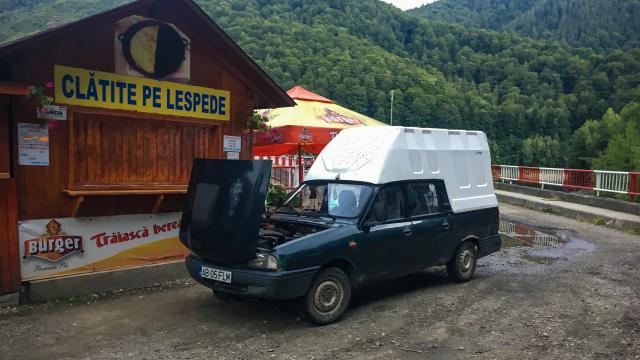Last week, I published a great big load of photos I took on our roadtrip through Ukraine. Driving on Ukrainian roads, you’re pretty sure to see a very weird variety of cars ranging from old Soviet era vehicles to Western cars you would never expect to see in Ukraine, such as a Mercury Topaz. But our trip didn’t end in Ukraine, as we crossed the border south to Romania with the famous Transfagarasan highway in mind.
Or at least that’s what everybody else was thinking about. The only thing I really cared about was seeing some Romanian-built cars.
Even if some customers can today buy a Ford crossover that’s put together in Romania, the official carmaker of Romania is Dacia. The company started out making badge-engineered Renaults, and it’s still building Renault-derived vehicles even today. The Duster is one of the best known Dacias, sold widely around the world, but since I can see those at home I didn’t get too excited about the numerous Dusters trundling around the streets of Romania.
The sedan you see here was essentially Dacia’s backbone for decades. The 1300 series from 1969 was based on the Renault 12, which was also imported to the United States as well. You can tell from the chrome that it’s a decently early car, one that could pass for a Renault with a change of badging.
However, Dacia kept churning out these curiously shaped little sedans for ever and ever, facelifting them a little over time but without really changing any of the basics. You could still buy a new one in 2004, albeit one that had mutated into something really strange looking yet which was still easily recognised as a Dacia.
And while Renault only offered the 12 as a sedan, a wagon and a panel wagon, Dacia eked out every little opportunity it could see in the basic platform. Take a look at this doppelkabin version finished in fire engine red:
Dacia took the time to extend the wheelbase for pickup duty, but the doors were fine as is. The engine in these is the 1.9-litre Peugeot diesel seen in quite a few different cars, including some Toyota Corollas.
Dacias weren’t the only pickups made in Romania. For tougher duty, there was the ARO 320, which certainly resembles a Land Rover, but which isn’t even related to any Land Rover knock-offs like the Santana. There were even plans to import these to the United States in the early 2000s, but nothing came out of that except some Mike Spinelli era Jalopnik articles.
More modern Dacia models included the Nova and the SuperNova, which kind of look if one were to describe a Renault 19 or a Peugeot 309 over the phone to a guy who had already started drawing a Nissan Sunny, or vice versa.
But! The Transfagarasan. It’s still a spectacular place to drive to, even if weather wasn’t really on our side. Early August was rainy time to be in Transylvania, and the days we had to spend near Transfagarasan were sometimes so foggy you couldn’t really see the serpentine roads in the valleys. At least the other side of the mountain was temporarily visible.
On the mountainside, we came across these heroes enjoying the twists and turns in a rear-engined Skoda. Judging by the plates and Czech nationality stickers, they were on a roadtrip of their own.
But this car was the highlight of my time in Romania. Before even starting out on the trip, I had declared there was one Romanian-built car I really had to catch and document, and here it was, abandoned on the side of a road at a slumbering village.
The Oltcit.
As soon as I had caught a glimpse of the rusted hulk sinking into the greenery, I demanded the Panda be stopped and jumped out the passenger door.
“What did he see?” “I think he said it was some old shit.”
The Oltcit was a joint venture with Citroën and the Romanian government. It was born out of Citroën’s “Projet Y” city car concept, which was one of the proposals for the 2CV replacement. A further development was realised as the Visa, but the earlier stage was put into production in Romania.
Even if the car wasn’t far from a decontented, three-door Citroën hatch, the Oltcit still got the funky dashboard controls instead of regular steering column stalks.
I don’t think they’re particularly great cars, and I don’t think anyone else does, but managing to see one in the (corroding) metal was one of the things I wanted to accomplish on my journey. I’m glad I caught this one.
Eventually, we left Romania and headed west. There were some great weird cars to be seen in Slovakia, Czechia and Hungary, so I wanted to include those in this article
Putting ‘80s Pontiac wheels on a Volkswagen Jetta isn’t the first thing that would come to mind, but it’s great to see someone had thought of that.
Out of all old Skodas we saw on the trip, I think this faded green one was my favourite. It sat on a used car lot in a small town in the Czechian countryside.
After years of making those rear-engined sedans, Skoda got a break and launched the front-engined, front-wheel-drive, Bertone-designed Favorit. The hatchback drove the company to Volkswagen’s arms, and it’s one of the key elements in Skoda’s story towards becoming the major player it is today.
This teal Honda Prelude was one of the raddest cars we saw on the trip, and I was lucky to get a decent photo of it from a bus window, as we were on our way to the Budapest city centre to meet up with Hungarian Jalopnik alumnus, Máté Pétrany. I think the Honda is a fitting end to this travel series, one of those once-common cars you don’t necessarily expect to see anymore. But with your camera ready, travelling in strange lands, you can spot anything if you’re lucky.
